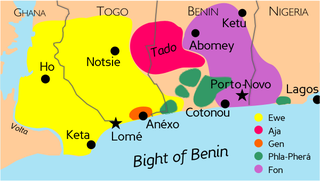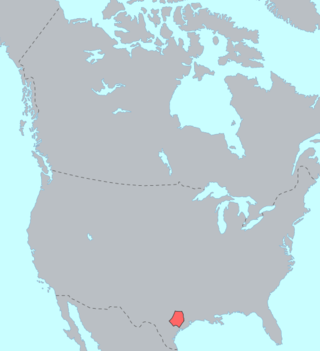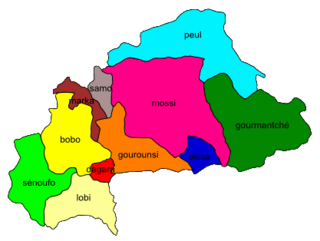Related Research Articles

A diacritic is a glyph added to a letter or to a basic glyph. The term derives from the Ancient Greek διακριτικός, from διακρίνω. The word diacritic is a noun, though it is sometimes used in an attributive sense, whereas diacritical is only an adjective. Some diacritics, such as the acute ⟨ó⟩, grave ⟨ò⟩, and circumflex ⟨ô⟩, are often called accents. Diacritics may appear above or below a letter or in some other position such as within the letter or between two letters.

Dyula is a language of the Mande language family spoken mainly in Burkina Faso, Ivory Coast and Mali, and also in some other countries, including Ghana, Guinea and Guinea-Bissau. It is one of the Manding languages and is most closely related to Bambara, being mutually intelligible with Bambara as well as Malinke. It is a trade language in West Africa and is spoken by millions of people, either as a first or second language. Similar to the other Mande languages, it uses tones. It may be written in the Latin, Arabic or N'Ko scripts.

Ewe is a language spoken by approximately 5 million people in West Africa, mainly in Ghana and Togo. Ewe is part of a group of related languages commonly called the Gbe languages. The other major Gbe language is Fon, which is mainly spoken in Benin. Like many African languages, Ewe is tonal as well as a possible member of the Niger-Congo family.
Neo-Mandaic, also known as Modern Mandaic, sometimes called the "ratna", is the modern reflex of the Mandaic language, the liturgical language of the Mandaean religious community of Iraq and Iran. Although severely endangered, it survives today as the first language of a small number of Mandaeans in Iran and in the Mandaean diaspora. All Neo-Mandaic speakers are multilingual in the languages of their neighbors, Arabic and Persian, and the influence of these languages upon the grammar of Neo-Mandaic is considerable, particularly in the lexicon and the morphology of the noun. Nevertheless, Neo-Mandaic is more conservative even in these regards than most other Neo-Aramaic languages.

Supyire, or Suppire, is a Senufo language spoken in the Sikasso Region of southeastern Mali and in adjoining regions of Ivory Coast. In their native language, the noun sùpyìré means both "the people" and "the language spoken by the people".
The Sucite language or Sicite is a Senufo language spoken in southwestern Burkina Faso and Mali by approximately 35,000 people. Sucite is a close neighbour of the Supyire language, spoken in southeastern Mali. Sucite is sometimes regarded as the northern extension of the Supyire language. The two dialects are, according to Garber (1987), ‘quite mutually intelligible’. Sometimes speakers of Sucite will even refer to themselves as speaking Supyire. Another closely related lect is Mamara.

The Tonkawa language was spoken in Oklahoma, Texas, and New Mexico by the Tonkawa people. A language isolate, with no known related languages, Tonkawa has not had L1 speakers since the mid 20th centiury. Most Tonkawa people now only speak English, but revitalization is underway.
Kusaal is a Gur language spoken primarily in northern eastern Ghana, and Burkina Faso. It is spoken by about 121,000 people and takes its name from the Kusaal people, or Kusasi. There is a distinctive dialect division between Agole, to the East of the Volta River, and Toende, to the West. Agole has more speakers. The 6-district capital; Bawku West with Zebilla as capital and the rest; Binduri, Bawku, Tempane, Garu and Pusiga districts mostly Agole dialect speakers. The complete Bible translation is in the Agole dialect.

The Mixtec languages belong to the Mixtecan group of the Oto-Manguean language family. Mixtec is spoken in Mexico and is closely related to Trique and Cuicatec. The varieties of Mixtec are spoken by over half a million people. Identifying how many Mixtec languages there are in this complex dialect continuum poses challenges at the level of linguistic theory. Depending on the criteria for distinguishing dialects from languages, there may be as few as a dozen or as many as fifty-three Mixtec languages.
Ixcatec is a language spoken by the people of the Mexican village of Santa María Ixcatlan, in the northern part of the state of Oaxaca. The Ixcatec language belongs to the Popolocan branch of the Oto-manguean language family. It is believed to have been the second language to branch off from the others within the Popolocan subgroup, though there is a small debate over the relation it has to them.
The Gurunsi, or Grunshi, are a set of related ethnic groups inhabiting northern Ghana and south and central Burkina Faso.

Dagaare is the language of the Dagaaba people of Ghana, Burkina Faso, and Ivory Coast. It has been described as a dialect continuum that also includes Waale and Birifor. Dagaare language varies in dialect stemming from other family languages including: Dagbane, Waale, Mabia, Gurene, Mampruli, Kusaal, Buli, Niger-Congo, and many other sub languages resulting in around 1.3 million Dagaare speakers. Throughout the regions of native Dagaare speakers the dialect comes from Northern, Central, Western, and Southern areas referring to the language differently. Burkina Faso refers to Dagaare as Dagara and Birifor to natives in the Republic of Côte d'Ivoire. The native tongue is still universally known as Dagaare. Amongst the different dialects, the standard for Dagaare is derived from the Central region's dialect. Southern Dagaare also stems from the Dagaare language and is known to be commonly spoken in Wa and Kaleo.
Puguli or Phuie (Pwĩẽ) is the language of the Phuo people. It is spoken in Burkina Faso.

Kasena or Kassena is the language of the Kassena ethnic group and is a Gur language spoken in the Upper East Region of northern Ghana and in Burkina Faso.
Farefare or Frafra, also known by the regional name of Gurenne (Gurene), is a Niger–Congo language spoken by the Frafra people of northern Ghana, particularly the Upper East Region, and southern Burkina Faso. It is a national language of Ghana, and is closely related to Dagbani and other languages of Northern Ghana, and also related to Mossi, also known as Mooré, the national language of Burkina Faso.
Konkomba is a Gurma language spoken in Ghana, Togo and Burkina Faso.
Gourmanché is the language of the Gurma people. It is the largest by number of speakers of the Gurma subgroup of the Oti–Volta languages, which includes among others the Moba language and the Konkomba language. It is the major language of the easternmost parts of Burkina Faso, around the traditional Gurma capital Fada N'gourma; it is also spoken in neighbouring parts of northern Togo, Benin, Niger, Ghana and Nigeria.
Turka (Turuka) or Curama, is a Gur language which is spoken by the Turka people in southwest Burkina Faso. Its closest linguistic relative is the Cerma language: however, they are not mutually intelligible. Due to economic, religious and educational influence, many Turka people also speak Arabic and Jula.

Tammari is a language which is spoken in Benin and Togo. It is also known as Ditammari. The Tammari people, who live in Benin and Togo, mostly speak the language. There are about 47.000 speakers. About half live in Togo, the other half in Benin. Ditammari is one of the Gur languages.
Manza is a Ubangian language spoken by the Mandja people of the Central African Republic. It is closely related to Ngbaka and may be to some extent mutually intelligible.
References
- ↑ Lyélé at Ethnologue (25th ed., 2022)

- ↑ Bhat, D.N.S. 2004. Pronouns. Oxford: Oxford University Press. p. 8
- 1 2 3 Nikiema 1993, p. 50.
- ↑ Nikiema 1993 does not list the circumflex accent but it is used in the 2001 Bible translation published by Wycliffe Bible Translators.
Works cited
- Nikiema, Norbert (1993). "Burkina Faso". In Rhonda Hartell (ed.). Alphabets des langues africaines. Dakar: Unesco – Bureau régional de Dakar et Société international de linguistique (SIL). pp. 41–56.